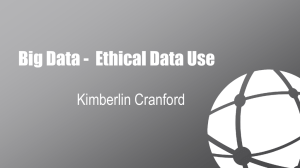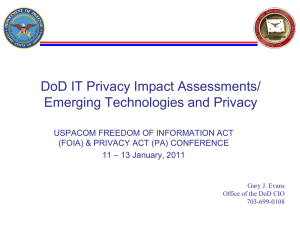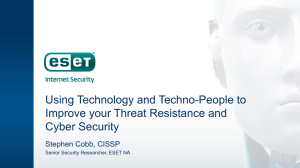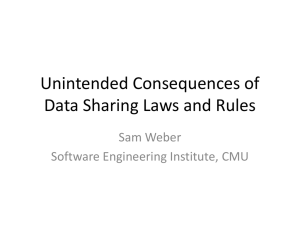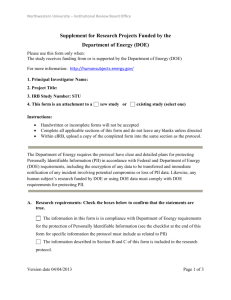Safeguarding Personally Identifiable Information - tri
advertisement
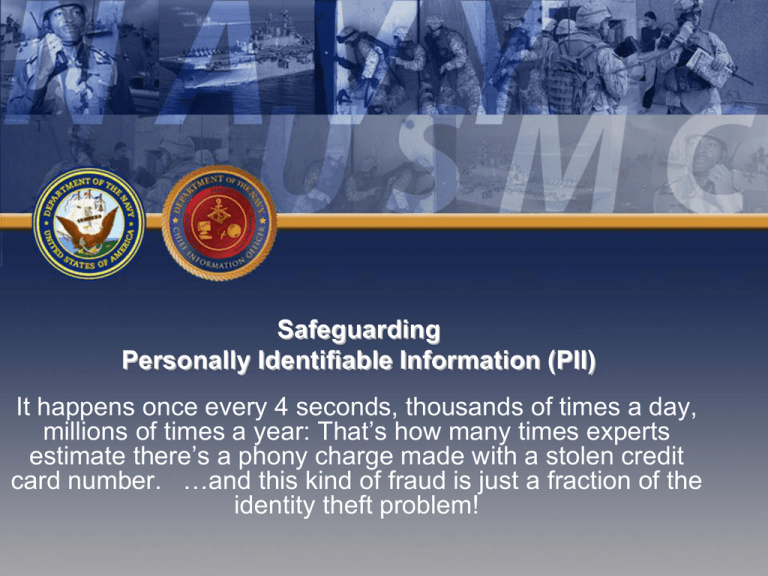
Safeguarding Personally Identifiable Information (PII) It happens once every 4 seconds, thousands of times a day, millions of times a year: That’s how many times experts estimate there’s a phony charge made with a stolen credit card number. …and this kind of fraud is just a fraction of the identity theft problem! Agenda • • • • • • • • • • What’s New With DON Privacy? Definitions Elements of a Great Privacy Program The Basics about Identity Theft PII Breach Trends and Recent PII Breaches Phishing The DON SSN Reduction Plan Top 10 Privacy Lessons Learned Final thoughts… Privacy POC’s 2 What’s New with DON Privacy? • New DON CIO, Terry Halvorsen, Senior Military Component Official for Privacy– oversees DON Privacy Program • SSN Reduction Plan Phase I for Forms underway • DoD requirement to discontinue posting of last four of SSN to public facing web sites (e.g. promotion messages) What’s New Continued… • Hard Drive Disposal Policy Message • Hard Drive Disposal Poster • In chop, Draft Reduction of SSN Use in DoD Instruction • Jan-Mar 2011 CHIPS Magazine with SSN focus – available today • Consolidation of DON Privacy functions/offices under review Privacy Awareness Posters Personally Identifiable Information (PII) Definition PII Definition: “…information about an individual that identifies, links, relates, or is unique to, or describes him or her, e.g., a SSN; age; rank; grade; marital status; race; salary; home/office phone numbers; other demographic, biometric, personnel, medical and financial information.” DoD Memo 21 Sep 07 6 Sensitive and Non-Sensitive PII Sensitive PII which may cause harm to an individual if lost/compromised • Financial information- bank account #, credit card #, bank routing # • Medical Data- diagnoses, treatment, medical history • Full Social Security Number • NSPS/Personnel ratings and pay pool information • Place and date of birth • Mother’s maiden name • Passport # • Numerous low risk PII elements aggregated and linked to a name Non-Sensitive PII, all authorized use under DON policy and considered “low risk” • Badge number • Job title • Pay grade • Office phone number • Office address • Office email address * • Lineal numbers • Full name * Cautionary note: Growing problem with email phishing 7 PII Breaches • A breach is defined by Office of Management & Budget as: “A known or suspected loss of control, compromise, unauthorized disclosure, unauthorized acquisition, unauthorized access, or any similar term referring to situations where persons other than authorized users and for an other than authorized purpose have access or potential access to personally identifiable information, whether physical or electronic” • Reporting required when a known or suspected loss, theft or compromise of PII occurs: – Use OPNAV Form 5211/13 to make initial and follow up reports – Send to: US-CERT within 1 hour of discovering a breach has occurred (*United States-Computer Emergency Readiness Team) • To the DON CIO Privacy Office within 1 hour • To the Defense Privacy Office • To Navy, USMC, BUMED chain of command, as applicable • DON CIO Privacy Office will determine within 1 working day the need to notify affected personnel - weigh risk of identity fraud. • Within 24 hours provide DON CIO follow up report. • Within 30 days provide DON CIO lessons learned. 8 • • • • • • • Seven Elements of a Great Privacy Program Leadership Risk Management and Compliance Information Security Incident Response Notice and Redress for Individuals Privacy Training and Awareness Accountability Information Security Privacy and security programs are complementary – must work together Information security must be a priority and message continually reinforced • Build security and privacy controls in early project development and all stages of to know lifecycle –– Need Take a “less is more” approach with PII collection Incident Response • If your office handles PII, written procedures must be in place to: – Detect, report and respond to privacy incidents • Timely response and mitigation of risk are critical • The discovering contractor/vendor has an obligation to report the PII breach • The accountable vendor has the responsibility of working with DON command to notify affected personnel • Applying lessons learned are key Privacy Training and Awareness • Training reinforces policy and best practices and helps create a privacy culture • All contractors under contract with DON must: – Require all employees to complete annual PII training • If responsible for causing a breach: – Proposed policy will require each individual to take PII Refresher training Accountability • Take “Big stick” approach or do nothing? – Must be a balance – Focus on correcting human error and malicious intent • Ensure contracts include FAR PII language • Take corrective action where there are program deficiencies and follow up • Consider Identity theft protection I D E N T I T Y T H E F T IS REAL! Basic Facts About Identity Theft • • • • • • • • • FTC reports 8M+ of U.S. adult population has experienced ID theft in ‘10, expect to see that grow during economic decline; Most fraud costs are passed to businesses. In ’05 1.8M cases new account fraud; 6.5M cases existing account fraud. Account fraud only 23% of the problem! Crimes are still more often offline (90%) than online. Consumer controls 63% of potential ID theft problem; detects 47% of cases. Risk is greatest when information was stolen by someone targeting the data e.g. hacker, burglar. ½ of known ID thieves were known by victim; ¼ were dishonest employees. Social Security numbers are "the most valuable commodity for an identity thief.“ Can obtain from public records free or buy on internet for $25 per SSN. Phishing attacks aimed at ID theft a real and growing threat. – Banks, Pay Pal, bogus job offers • • • Generation X (25-34) highest fraud rate (5.4%); 65+ lowest. ID theft of children and people who are deceased, a growing problem. FYI, by law, consumer credit card liability is $ 50.00; Debit card is $50.00 if reported within 48 hrs; $500.00 if reported w/in 60 days; after 60 days may lose all $’s in account plus overdraft amount! 15 ID Theft Trends These statistics represent the growth from 2006 to 2007 - Arrest warrants issued in victims names due to Financial Crimes – 24% to 62% increase* - Fraudulent drivers licenses - 16% to 32% increase * - Fraudulent employment - 13% to 41% increase * - Fraudulent tax refunds - 11% to 59% increase * -Received Government assistance with victims information - 6% to 27% increase * -Additional 250,000 to 500,000 Victims of Medical Identity Theft reported each year * *Information gathered by the IDTRC and Chicago Tribune 16 What Are the Fixes To Reduce ID Theft? Must have a comprehensive, multi faceted approach. • Reduce/eliminate the supply of SSNs and “high risk” PII available to thieves – – – – – Remove SSNs from all public records Remove the SSN from DoD and DON forms, when possible Reduce the display, storage and transmission of SSNs and PII Improve data and personnel security Create strict laws that make the sale of SSNs a crime • Reduce the demand for SSNs by minimizing their value to ID thieves. – Require/encourage adoption of more effective authentication procedures by financial institutions – Aggressively prosecute ID thieves 17 TRENDS and PATTERNS • Increase in number of “insider” caused breaches • Confirmed identity theft cases remains low • Rise in incidents involving recall roster and spreadsheet attachments sent via email and shared drive disclosures • Drop in incidents involving SSNs from 80% to 54% over the past 12 month period • Decrease in number of impacted personnel by 50% over the past 12 months Recent Breaches • Used Navy copiers erroneously sold before hard drives sanitized. Error realized before copiers were received by new owner and recovered by DON. Contained PII and other sensitive info. Sep 09 • Unencrypted laptop stolen/missing from Naval pharmacy containing SSNs and patient names. Aug 09 • Employee downloaded PII to unencrypted CD, transferred to new command, soon after arriving lost the CD and filed a breach report. Oct 09. • Sailor and his civilian girlfriend were allegedly attempting to steal the identity of multiple staff members. Several staff members had complained about attempts being made to take out credit in their names. Jan 10 • PO2 sold PII of service members to group who created bogus tax returns. All returns mailed to same address! Apr 10 • Laptops stolen as part of “tech refresh” process. Some DAR protected, some not. Investigation ongoing. Sep 10 19 PII Breach Media Must have tight controls/permissions Improving but only takes one Still # 1 20 PII Breach Media What happens to the digital images when a copier is turned in? Sent to recipients “without a need to know” / unencrypted. 21 Breach Causes 180 160 140 Number of Incidents 120 100 80 60 40 20 0 Human Error Theft Unknow n Postal Insider Threat Hacker 22 Type of PII Lost, Stolen or Compromised 200 180 160 Number of Incidents 140 120 100 80 60 40 20 0 SSN Medical Financial NSPS Passport 23 Phishing Phishing is the process of attempting to acquire sensitive information such as usernames, passwords or financial account details by masquerading as a trustworthy entity in an electronic communication. This is a growing activity within the DON. Perpetrators ask you to click a link back to a spoof web site. Doing so could subject you to the installation of key logging software or viruses. They use fear to motivate you to respond – “your account has been temporarily suspended due to recent fraudulent activity, we need you to verify your account information…” Never open emails from unknown sources or institutions soliciting: Passwords Credit card information ATM/Debit Card number Social Security Number Bank/financial account number If in doubt about validity of the email, call their customer service number. Notify your network administrator. For NMCI go to: https://www.homeport.navy.mil/support/articles/report-spam-phishing/ 24 Human error Flash storage media Budget and resources Changing business processes IT systems Records management Teleworking DON culture Hard drives Hackers Blogs Disposal of storage media Official and unofficial forms Contractor services Web portals and shared drives Insider threat Spreadsheets Email Malicious software Data mining 25 Acceptable SSN Uses DoD Guidance lists 12 cases for Acceptable Uses of SSNs (Collection, Use, or Retention): - Geneva Conventions Serial Number (on a timeline to to change/eliminate SSNs from ID cards) - Law Enforcement, National Security, and Credentialing - Security Clearance Investigation or Verification - Interactions with Financial Institutions - Confirmation of Employment Eligibility - Administration of Federal Worker’s Compensation - Federal Taxpayer Identification Number - Computer Matching - Foreign Travel - Noncombatant Evacuation Operations - Legacy System Interface - Other Cases (with specified documentation) 26 DRAFT DON SSN Reduction Plan GOAL: Reduce or eliminate the use, display, collection, dissemination or storage of SSNs across the DON. • Phase 1 - focus on justifying continued use/collection of SSNs in official Navy/Marine Corps forms and IT systems. • Phase 2 – Where SSNs are still needed and where applicable, substitute using the Electronic Data Interchange Personal Identifier (EDIPI). • Challenges: – DoD must provide guidance on the use of the EDIPI-must have controls or we create another SSN. – Elimination of the SSN or substituting the SSN for another identifier will incur unfunded program costs. 27 Privacy Lessons Learned • Support and involvement from senior leadership is key. • Aggressive PII compliance spot checks with corrective action taken are very effective. • Eliminate/Reduce the use, display and storage of all PII whenever possible. • Mark all documents containing PII with FOUO Privacy Sensitive warning. • Ensure shared drive access permissions are established and routinely checked. • Special care must be taken when moving, closing or consolidating offices that handle PII. • Closely scrutinize employees/contractors that have access to PII. • Paper documents and hard drive disposal methods must be better defined and tightly controlled. • A command records management program with records disposal schedule is an effective tool to reducing PII. • Campaign continuously to increase PII awareness. 28 Some final thoughts… • Penalties under the Privacy Act apply to contractors • Revisions to the FAR under discussion • Consider credit monitoring for vendor caused breaches • Doncio.navy.mil web site is a great privacy resource: – FAQs, PIA Gouge, Breach Reporting Forms, Credit Monitoring Info, Privacy Reading List, Table Of Consequences, Posters, Tips of the Month • PII Info Alert 29 DON Privacy POCs STEVE MUCK ROBIN PATTERSON SAM YOUSEF DON CIO DON Privacy Team Lead Phone: (703) 601-0081 Email: steven.muck@navy.mil OPNAV DNS-36 HQMC C4 CYBER SECURITY DIVISION PII/PIA Analyst Phone: (571) 256-8876 MICHELLE SCHMITH DEBORAH CONTAOI MAJOR PRASSERTH YANG DON CIO Phone: (703) 602-6110 Email: michelle.schmith@navy.mil OPNAV DNS-36 Phone: (202) 685-6546 Email: teri.contaoi.ctr@navy.mil HQMC C4 CYBER SECURITY DIVISION Identity Management Branch Head Phone: (571) 256-8862 Email: prasserth.yang@usmc.mil DON Privacy Act Program Manager Phone: (202) 685-6545 Email: robin.patterson@navy.mil STEVE DAUGHETY DON CIO Phone: (703) 602-6393 Email: steve.daughety1.ctr@navy.mil 30
